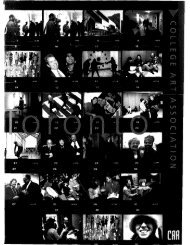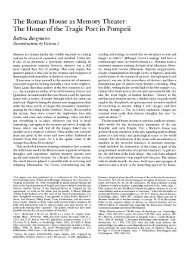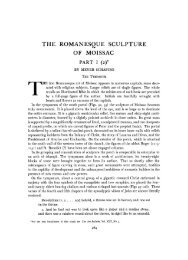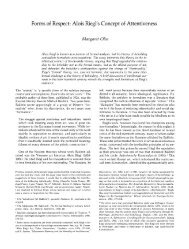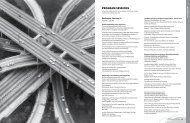THE HUMANISTIC THEORY OF PAINTING - College Art Association
THE HUMANISTIC THEORY OF PAINTING - College Art Association
THE HUMANISTIC THEORY OF PAINTING - College Art Association
Create successful ePaper yourself
Turn your PDF publications into a flip-book with our unique Google optimized e-Paper software.
UT PICTURA POESIS: <strong>HUMANISTIC</strong> <strong>THE</strong>ORY <strong>OF</strong> <strong>PAINTING</strong> 203<br />
anticipating Lessing had already put his finger at the root of the trouble when he wrote:<br />
Les mots et les couleurs ne sont choses pareilles<br />
Ni les yeux ne sont les oreilles.30<br />
I-IMITATION<br />
This essay will first attempt to sketch the development of the humanistic theory of<br />
painting in European criticism of the sixteenth and seventeenth centuries, noting how it is<br />
everywhere pervaded and molded by the direct or implied comparison of painting with<br />
poetry; it will then test one aspect of the theory by applying it to a capital example in the<br />
Baroque period of the impact of poetry on the sister art-the illustration of a famous<br />
episode of Tasso's Gerusalemme liberata among the painters of the seventeenth century.<br />
Inasmuch as the doctrine of imitation was the corner-stone of Renaissance as it had been<br />
of ancient aesthetic, one may reasonably begin a discussion entitled ut pictura poesis with<br />
a consideration of the manner in which the Italian critics of the sixteenth century applied<br />
to the art of painting a doctrine which the ancients had developed chiefly as it concerned<br />
the art of literature.<br />
First of all, the critics observed in language unmistakably Aristotelian that painting<br />
like poetry was an imitation of nature, by which they meant human nature, and human<br />
nature not as it is, but, in Aristotle's phrase, as it ought to be,31 "raised," as a modern writer<br />
has well expressed it, "above all that is local and accidental, purged of all that is abnormal<br />
and eccentric, so as to be in the highest sense representative."32 In the sixteenth cen-<br />
tury the doctrine of ideal imitation had not yet entirely supplanted the older and scarcely<br />
compatible notion that art is an exact imitation of nature, and it is not unusual, at least<br />
until past the middle of the century, to find them disconcertingly side by side-a fact<br />
which, the reader will agree, does not argue for the philosophical capacities of these writ-<br />
ers. The concept of literal imitation had occurred already in the Trecento,33 and was<br />
the natural accompaniment during the Quattrocento of a realistic point of view and practice<br />
among those artists who were striving strenuously to capture the perfect illusion of visible<br />
this relationship, see his "Ut pictura poesis" in Publ. of the<br />
Mod. Lang. Assn. of America, xxIv, 1909, 40-123. Howard<br />
has availed himself of the learned introduction and com-<br />
mentary in Hugo Bliimner's monumental edition of the<br />
Laokoon, Berlin, 188o.<br />
30. Conte du Tableau. Various writers have called atten-<br />
tion to La Fontaine's anticipation'of Lessing.<br />
31. See especially the famous passage (Poetics xx. 1-3)<br />
where Aristotle states that poetry is more philosophic and<br />
serious than history because it reveals general truths,<br />
whereas history gives only particular facts; and cf. xv. ii<br />
(see Bellori's translation below, note 64) and xxv. 1-2.<br />
The literary theorists of the Cinquecento frequently re-<br />
mark that poetry is like painting in its power to idealize<br />
nature. Fracastoro (Naugerius sive de poetica dialogus,<br />
Venice, 1555; I quote from the text reprinted by Ruth<br />
Kelso in University of Illinois Studies in Language and Liter-<br />
ature, Ix, 1924, P. 158) remembering Plato and Aristotle,<br />
states that the poet is not like the realistic painter who<br />
paints things as they are, but like the painter who contem-<br />
plating the most fair and universal idea of his creator fash-<br />
ions them as they ought to be: "Video, o amici, in paucissi-<br />
mis illis tanti philosophi verbis illuscere ac patefieri nobis<br />
poetae officium ac finem: alii siquidem singulare ipsum<br />
considerant, poeta vero universale, quasi alii similes sint<br />
illi pictori, qui et vultus et reliqua membra imitatur, qualia<br />
prorsus in re sunt, poeta vero illi adsimiletur qui non hunc,<br />
non illum vult imitari, non uti sorte sunt et defectus multos<br />
sustinent, sed universalem, et pulcherriman ideam artificis<br />
sui contemplatus res facit, quales esse deceret." In like<br />
manner Scaliger compares Virgil, for him the paragon<br />
among ancient poets, with those painters and sculptors<br />
who, selecting the best from many objects in nature and<br />
combining these excellences into one image, seem "not to<br />
have learned from nature, but to have vied with her, or<br />
rather to have created laws for her to obey" (Poetices,<br />
Geneva, 1561, IIx, 25, p. 113). The passage is quoted and<br />
receives further comment in note 43. For a general survey<br />
of the theory of poetry during the Renaissance which it<br />
may be useful to compare with my discussion of the literary<br />
theory of painting, see Spingarn's Literary Criticism in the<br />
Renaissance, especially pp. 3-59.<br />
32. Quoted from Babbitt, op. cit., p. 10.<br />
33. For instance in Boccaccio's praise of Giotto's ability<br />
to paint so accurate a likeness of things that men mistook<br />
his paintings for reality; see Decameron, vi, 5. This recalls<br />
Pliny.



